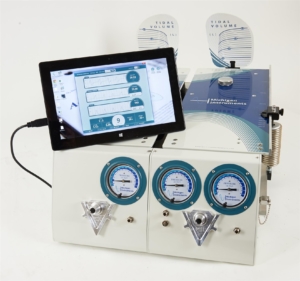A number of our customers have been requesting information on how to simulate a pneumothorax using the Michigan Instruments Dual Adult Lung. The following will describe how this condition can be simulated on a Training & Test Lung, using setup options offered by this device. The principles described can be applied to many laboratory situations that do not require the use of this lung.
A pneumothorax is usually characterized in humans by a collection of gas or fluid between a lung and the wall of the chest cavity. The added pressure (usually on only one lung) created by this condition often results in a patient having one uncompliant lung and one healthy lung—a situation in which standard ventilation can be difficult or even dangerous to perform.

The Simulation
This scenario can be simulated on a model 1600 or 5600i TTL by reducing the compliance of one lung (usually to 0.02 or 0.03 liters/cmH2O) while leaving the second lung in a healthy state (0.05 liters/cmH2O).
Airway resistances should be left within the normal healthy range (Rp20 for upper airway, Rp5 for lower airway) unless a compound pneumothorax is being simulated. When a TTL set up in this manner is ventilated the operator will note that, while pressures are relatively even throughout the system, volume and flow are heavily skewed toward one lung (as it would be in an actual patient scenario).
The pneumothorax can be accentuated (for observational purposes only) by further reducing the compliance of the affected lung (to 0.01 liters/cmH2O) and setting the upper and both lower airway resistances to Rp20. This extreme scenario, while effective at conveying the effects of a pneumothorax, is not representative of a simple pneumothorax in humans and should not be used to assess the effectiveness of treatment methods for this condition.
Most test lungs can be used to simulate many different pulmonary conditions. If you have questions on how to create a specific scenario on your test lung please leave a comment below or contact techsupport@michinst.com. More information is available at https://www.michiganinstruments.com/training-test-lungs/.

